
–ефераты по биологии
–ефераты по экономике
–ефераты по москвоведению
–ефераты по экологии
раткое содержание произведений
–ефераты по физкультуре и спорту
“опики по английскому €зыку
–ефераты по математике
–ефераты по музыке
ќстальные рефераты
–ефераты по авиации и космонавтике
–ефераты по административному праву
–ефераты по безопасности жизнеде€тельности
–ефераты по арбитражному процессу
–ефераты по архитектуре
–ефераты по астрономии
–ефераты по банковскому делу
–ефераты по биржевому делу
–ефераты по ботанике и сельскому хоз€йству
–ефераты по бухгалтерскому учету и аудиту
–ефераты по валютным отношени€м
–ефераты по ветеринарии
–ефераты дл€ военной кафедры
–ефераты по географии
–ефераты по геодезии
–ефераты по геологии
–еферат: Tourism in Germany
–еферат: Tourism in Germany
The South Ural State University The paper work: TOURISM IN GERMANYWritten by:
Shamanova Nadejda Andreevna
Group: S-151
Checked by:
Kovaleva Olga Ivanovna
Chelyabinsk
2004Contents
Introduction. 4
1. Germany.. 5
2. Getting there.. 7
3. Accommodation in Germany. 10
4. Where to go. 13
4.1.Festivals. 13
4.2. National Parks. 15
4.3. Routs in Germany. 20
5. A Journey to Berlin.. 24
5.1. Accommodation in Berlin. 24
5.2. Sightseeing in Berlin. 28
5.3. Eat, Drink, Nightlife. 32
Conclusion. 34
Literature.. 35
Sites. 35
Introduction.
Germany is rich by its tourist recourses. Each land has a lot of various places of interest. ЂCome and be enchanted by the HISTORIC HIGHLIGHTS OF GERMANY!ї - This is the motto chosen by thirteen historic German cities that have joined together to offer you some truly incomparable travel experiences. They will all fascinate and delight you - Augsburg, Bonn and Bremen; Erfurt, Freiburg, Heidelberg and Lübeck; Münster and Potsdam; Regensburg and Rostock; Trier and Würzburg.
Each of these many-faceted cities is steeped in history. At every turn you will encounter the great names of the past and enjoy the architectural and artistic heritage of great eras. Deep in the heart of Europe, Germany has had a seminal impact on Continental history. From the Holy Roman Empire to Otto Von Bismarck's German Reich, Nazism and the rise and fall of the Berlin Wall, no other nation has moulded Europe the way Germany has - for better or worse.
Here, history really comes to life. And life comes to life too- in every season the calendars are jam-packed with events for every taste: Top quality concert series, art exhibitions, outstanding theatre, major international sporting events, colourful street festivals and traditional Christmas Markets sparkle with lights. This rich, interwoven tapestry of the past and the modern is also the key to the charm and dynamism of the historic highlights.
Fairy-tale castles, medieval towns, boisterous beer halls, breathtaking landscapes and a cutting-edge arts scene - the land of Beethoven and Bratwurst delights, excites and inspires.
1. Germany
The lowlands in the north of Germany stretch from the Netherlands to Poland, skimming southern Denmark where it bridges the North and Baltic seas. The industrialised central belt cinches Belgium and Luxembourg to the Czech Republic's western prong. The Rhine and Main Rivers, long crucial for inland shipping, power through the troughs and gorges which cut through the Central Uplands. To the south, the Danube River drains the Bavarian highlands from the Black Forest, near the French and Swiss borders, to Munich. The southern reaches of the Bavarian Alps give way to Austria.
Germany is not prey to dramatic climatic extremes, although there are regional differences. The most reliably good weather is from May to October, with high summer a good bet for shorts and T-shirt, even in the north. Autumn is a good time to visit Germany. As the tourist scrum disperses and the forests turn golden, it's not too stifling to be active but still thirsty enough to end the day with a few well-deserved steins. Winter is wet, especially in the south, with snow rarely settling for long except in the high country.
Visas: EU citizens can enter on an
official identity card. Americans, Australians, Canadians, New Zealanders and
Japanese just need a valid passport (no visa). Unless you're a citizen of a
developing country, you can probably stay up to three months.
Time Zone: GMT/UTC +1 (Central European Time)
Dialling Code: 49
Electricity: 230V, 50Hz
Weights & measures: Metric
The German climate is variable so it's best to be prepared for all types of weather throughout the year. That said, the most reliable weather is from May to October. This coincides, naturally enough, with the standard tourist season (except for skiing). The shoulder periods can bring fewer tourists and surprisingly pleasant weather. There is no special rainy season.
Germans love to party, and kick up their heels at everything from pagan harvest romps to black tie opera galas. The Winter Carnival (Fasching) season occurs throughout Germany, with big cities such as Cologne (Köln), Munich and Mainz erupting into commotion just before Ash Wednesday. Germany's rich musical heritage is showcased in a plethora of festivals. Some towns concentrate on a particular composer, such as the Thuringian Bach Festival in March or the Richard Wagner Festival in Bayreuth each July, whereas others focus on a particular style. The jazz festivals in Stuttgart (April) and Berlin (November) are lively and popular. Autumn is a great time for harvest-inspired mayhem, especially in the Rhineland, where the Rhine in Flames frolics feature barges laden with fireworks. Mention must be made of Oktoberfest, Munich's annual lager frenzy, but it's a bit like being stuck in a nightmarish soccer crowd and is more an example of tourism at its lowest ebb than a display of German culture. Christmas fairs are embraced wholeheartedly by German families; they occur in Munich, Nuremberg, Lübeck, Berlin, Münster and Heidelberg, amongst other places.
†
2. Getting there
The main arrival/departure points for flights in Germany are Frankfurt-am-Main, Munich and Düsseldorf. Frankfurt is Europe's busiest airport after Heathrow. An airport departure tax of around US$5 is included in ticket prices. If you're already in Europe, it's generally cheaper to get to and from Germany by train or bus. While train travel is often more expensive than catching a bus, it's generally faster, more comfortable (particularly for overnight travel) and more efficient. Germany is served by an excellent highway system connected to the rest of Western Europe. Roads from Eastern Europe are being upgraded but some border crossings are a little slow, especially from Poland. To enter Germany with a car or motorbike, you must have third-party insurance. Ferries run between Germany's northern coast and Scandinavia and the UK.
By train. Getting around Germany is easy. Domestic air travel is extensive but unless you're in an awful hurry, you might as well save your money - the German train network is wonderful. The railway system enables everyone to travel comfortably to their destination. There are good connections to both distant and local areas. Airports (Berlin Schönefeld, Düsseldorf, Munich and Stuttgart) are also merged into this system. There are 60 different connections to the neighboring European countries that originate daily in Germany. The customs clearance usually takes place on the train once it has left the station.
The eastern and western train systems have now been fully merged, although fares in the east are still cheaper. Numerous fares and ticket passes are available. There is usually a surcharge for the InterCity Express (ICE) trains but it's worth it to travel 250km/h (155mph) through the German countryside. Forget about buses until you're in train-unfriendly terrain.
By bus. A European bus service completes the railway system. It offers special connections on particularly interesting routes to tourists. Information regarding the bus system is also available in each travel agency.
A journey by bus will guarantee comfortable travelling. Enjoy and experience towns and landscapes in a relaxing way. Lean back and enjoy the view of diverse landscapes from large bus windows or visit one of Germany´s famous towns.Get on and relax - once you are comfortably seated, your well-earned holidays will begin. Besides, you have chosen an environmentally friendly way of travelling.
Internationaler Bustouristik Verband e.V. (RDA), the international federation of bus tour operators, has set up a list of operators offering bus journeys. The list is set up according to the Lands of the Federal Republic of Germany and is available. Here you will find numerous journeys based on particular themes, sightseeing tours and club tours. It is also possible to set up your own journey in co-operation with the operator. Deutsche Touring GmbH offers attractive journeys on public service buses along Germany´s touristic holiday routes. Today Deutsche Touring is one of the most important bus companies in Europe. In cooperation with foreign partners, it provides regular international services linking over 700 cities throughout Europe. Regional and urban public transportation operators and associations offer a rich network of short distance bus trips.
By car. If you are travelling by car, an ultra-modern and efficient freeway network awaits you. Over 700 restaurants, gas stations, motels and kiosks are open day and night to travellers driving across the approximately 11,000 km freeway network of the Federal Republic.
German roads are excellent, and motorised transport can be a great way to tour the country, although most towns have problems with car-parking. The national and famous motorway network known as autobahn can be wonderful and nightmare.
Bicycle touring in Germany is very popular. There are often separate cycling routes in the cities, towns and in the countryside, but cycling on the autobahn is strictly not allowed.
†
3. Accommodation in Germany.
There is a wide variety of accommodation possibilities in Germany ranging from a private room to a vacation home up to a luxury hotel. There are also lower priced lodgings available. Either way, standards are set and checked so that you can expect a comfortable place to stay in every case. Hotel corporations and regional and local tourism organisations publish their own accommodation directories. You can make room reservations directly through the hotel chain reservation systems, hotel corporations, the airports and tourism organisations. Travel agencies also work closely with hotels.
More and more hotels and hotel chains in Germany are including youth specials into their programs. Special youth hostels and youth
hotels have dedicated and specialised themselves to tourists needs. They can
even be accommodated close to the city centers. Vacation villages and vacation
apartments are a good idea for spending more than one night somewhere. Tourists
can also spend the night at one of more than 2000 camping sites or in one of
over 600 youth hostels. Bed & Breakfast is not just a British speciality.
Almost all tourist information points can find you a private room on arrival
and can sometimes even make advance reservations.
††††† Hotel rooms in Germany have a wide selection of price ranges. You can
stay overnight in luxury suites, rooms in middle class hotels or very
inexpensive accommodation in smaller hotels. From Flensburg to Munich, from Aachen to Dresden, you can find hotels to fit your needs according to German hotel
classification standards. Hotels are classified based on a uniform criteria and
are categorised by a certain number of stars (i.e. **** = luxurious). Some of Germanys` finer hotels are Accor, ArabellaSheraton and Maritim
Camping & Caravaning
Whether staying in an RV trailer, motorhome or within the four walls of your tent, you can be right at home in any beautiful setting. For a few days or several weeks, delightful landscapes can be directly outside your front door. Relax in nature and recover from the hectic pace of everyday life. Germany offers an abundance of camp sites in areas chosen for the incredible scenery they possess, and their gates are open to everyone. For your vacation, you can choose from sites located in more tourist areas or, for longer stays, get away to more remote locations in the middle of the most gorgeous surroundings.
Guesthouses & inns
Besides hotels in all categories, there is naturally also a variety of guesthouses and inns which can be found almost everywhere in Germany. They offer a good opportunity for enjoying a low-priced vacation in a family atmosphere.
Youth hostels
The youth hostels in Germany are open to all people, whether young or old. Suitable for short visits or longer stays, hostels are ideal for many different types of people and activities. Guests can include single people, families, tour groups, sport teams and youth groups. They come for everything from vacation camps to ski trips as well as conferences and seminars. The only requirement is that one must be a member of the German Youth Hostel Association.
Vacation on a farm
The most beautiful time of the year is awaiting you right outside
your door.† Vacation farm areas can provide† with peaceful, unencumbered days.
Out in the country, you will find elements of life that you otherwise may not
experience. Instead of the hectic pace of everyday life that makes you feel
unacknowledged, you encounter real hospitality in a warm, personal atmosphere.
†††††† You will find yourself rejuvenated in such a natural setting whether
just walking outside, fishing, biking or horseback riding. There's no end to
the new experiences and discoveries you can make. The hosts of the farm will
spoil you with regional delicacies like fragrant fresh breads, home-made
sausages and cheeses as well as wine and juices from own vineyards. Diverse
leisure activities for both young and old round off the whole experience in the
country.
Bed and Breakfast
A Bed and Breakfast is typically a lower-priced alternative to hotels and inns. Instead of staying in anonymous hotel beds, you sleep in cosy, private guest rooms. You are welcomed cordially by your hosts who offer a pleasant atmosphere in which to enjoy your stay. In the morning, breakfast is prepared just for you according to your taste. Your hosts take a personal interest in helping you with providing tips and information about the area, the country and the people.
4. Where to go.
4.1.Festivals
From its beginning in post war Berlin, the Berlinale was
designed to be an international rather than a national film festival.
Over the years the festival has cemented its status as major European film
festival and is easily as important as its competitors in Venice and Cannes.
The Golden and Silver Berlin bear and many honorary awards are much
sought-after.
B) Love parade in Berlin
German
techno guru Dr. Motte and 150 of his closer friends started the rave in 1989.
They met at Berlin's 'Ku'damm' to celebrate a party and to demonstrate for
tolerance and love.
Successfully: the mobile party attracts en-vogue DJs and an enthusiastic crowd.
Some facts: In 2000, the loveparade's busiest year to date, 250 DJs on 53
wagons partied together with over a million guests.
Recently, Austria, Israel, South Africa and Mexico have joined the craze and
organised their own love parades.
C) Frankfurt's Bookfair
Frankfurt
is a big player in global trade fair business. An
annual average of 80 fairs and exhibitions attract numerous visitors from all
over the world.
One of the highlights is Frankfurt's book fair. The biggest book fair worldwide
dates back to the 15th century. Its popularity has increased ever since.
Today, more than 250,000 annual visitors flood the fair.
The aim: information on a selection of the almost 400,000 books which are being
presented. Readings, talks, interviews and other side events offer additional
incentives for an interested public. Book industry, publishers, critics,
readers and writers alike are under the spell of the biggest book fair world
wide.
D) Carnival in Germany
In Germany Mardi Gras ('Fasching') is also
referred to as the fifth and foolish season ('die närrische Zeit'). It is
a time of elaborate parades, masks, balls and election of Carnival king and
queen and official madness.
The exact time of celebration and the traditions vary from county to county,
but it generally takes place in early spring. Munich, Cologne, Mainz† are strongholds of Mardi Gras celebrations.
Switzerland and Austria, too, join the party with enthusiasm following
their own traditions.
E) Munich's 'Oktoberfest'
Even though it is called
'Oktoberfest', the festival actually takes place in September, as Bavarian
autumn can be tricky and surprise with early cold and snow. Today, the
'Oktoberfest' is the largest festival worldwide attracting a multitude of
visitors. Apart from beer tents the festival offers amusements as diverse as
roller coasters, circus appearances, festive parades and live brass bands.
The ceremonial opening happens at noon. The mayor arrives in a festive coach
followed by a decorated horse-drawn brewer's cart. Guests, staff and the
numerous brass bands are all wearing traditional costumes (lederhosen and
dirndls) for the occasion. At the end of the parade the major taps the first
keg of beer and shouts, "o'zapft is!" (The keg is tapped).
It takes good nerves and a solid stomach to survive the festivals 16 days of
intensive partying. However, the festival is a huge success: Apart from
attracting a multitude of visitors the festivals brand name 'Oktoberfest' has
been exported all over the world.
4.2. National Parks
A) The Jasmund National Park
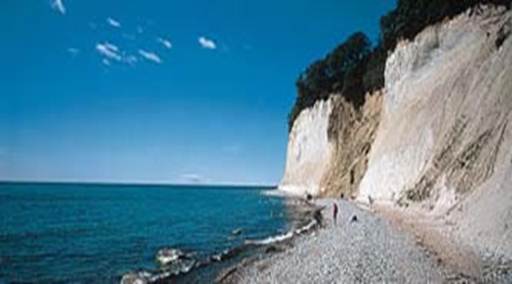 †
†
The Jasmund National Park offers many different landscapes within a very small area. Come and visit a cretaceous landscape with numerous bogs, wet grasslands and dry meadows. The most renowned attraction are the chalk cliffs surrounding the Königsstuhl which have been captured in paintings by the famous artist Caspar David Friedrich.
Apart from the Königsstuhl, the highest point on the chalk coastline, the whole length of the chalk coastline is impressive. It stretches over a length of 10 km, reaches a height of 117 m and consists of both active and inactive cliffs, illustrating the dynamics of an active steep coastline.
The national park offers a wide range of activities, such as hiking and bicycle tours, excursions and seminars which give the opportunity to explore the most beautiful hiking trails through the region´s forested landscapes.
The Stubnitz area is not just worth a visit
because of its magical chalk landscape, it is also the home of mythical figures.
On guided tours, organised on a regular basis by the national park
administration, you will find out everything about Hertha, a Germanic goddess,
and Störtebecker, a pirate who is said to have buried treasure somewhere
in this area.
Highlights:
- Cape Arkona with the little town of Vitt
- the fishing port of Sassnitz with its fishing museum
- "Piratenschlucht" (pirate´s gorge) in Sassnitz
- Greifswald's museum with an exhibition of paintings by Caspar David Friedrich
- historic craftsmen's dwellings in Gingst
- Grümbke lookout tower near Neuenkirchen
Activities:
Jasmund offers a wide range of guided tours (daily
tours take place from April - September, both from the parking lot in Hagen to the Königsstuhl and from Sassnitz to the bizarre rock formations of
"Wissower Klinken").
Furthermore, you can visit numerous exhibitions (at the national park
visitors´ center at the Königsstuhl and also at the Granitz hunting
lodge near Sellin).
The biosphere reserve "South East Rügen" organises further
hiking and bicycle tours, as well as excursions.
B) The Wadden Sea of Hamburg National Park
The Wadden Sea of Hamburg National Park, which is the smallest of
three mud-flats national parks, is characterized by three islands:
"Neuwerk", widely covered with meadows and with a population of 40,
"Scharhörn", with its sand dunes, and "Nigehörn"
which has been created artificially. The island group is located directly at
the mouth of the river Elbe near Cuxhaven in northern Germany and protects a landscape of approximately 12,000 hectares of wadden sea.
On guided tours you not only have the opportunity to
learn about the region´s landscape but also about the islands´
historical background.
†On the way from Neuwerk to Scharhörn you will walk along trails leading
across seemingly endless mud-flats. Scharhörn, which used to be a
sandbank, is a tourist attraction mainly for its sea bird colonies. On a visit
to the ornithological station you will see one of the largest colonies of sea
swallows.
Highlights:
- carriage ride across mud-flats from Sahlenburg to
the island of Neuwerk
- voyage with the MS "Flipper" from Cuxhaven to the island of Neuwerk
- guided walks across the Wadden sea
- guided tours to the bird colonies, salt marshes and wadden sea of Neuwerk
- guided tours to Scharhörn, the bird sanctuary
- searching for amber on the "Kleiner Vogelsand"
- amber exhibition on the island of Neuwerk
Activities:
We recommend national park visitors on day trips to
take a walk along the main dyke, from which you can see the foreshore with its
bird colonies but also the island´s interior. Cars are banned on the
islands. For this reason tours, for example, to the fortified tower of the island of Neuwerk, through the salt marshes of the foreshore with their abundance of flora
and fauna, or to the "Ostschleuse" lock, can either be made on foot
or by horse-drawn carriage.
C) The Wadden Sea of Lower Saxony National Park
Make a
trip to one of the most impressive wadden sea landscapes. High up, in northern Germany, at the North Sea coast of Lower Saxony, the Wadden Sea of Lower Saxony National Park is
located. It protects the wadden seas landscape between the river Ems and the
river Elbe, including the offshore East Frisian Islands. The national park
offers amazing natural spectacles and various landscapes, such as salt-marshes,
which are typical of this region, the steep coast near Dangast and the
"swimming bog" near Sehestedt, Germany's only remaining bog landscape
located outside the country's dykes
Highlights:
- Wadden Sea House in Wilhelmshaven
- Norddeich seal station
- Lightship and whale-bone fence on the island of Borkum
- Fisherman's House Museum on the island of Norderney
- Dornumsiel Castle, surrounded by water
- German Shipping Museum in Bremerhaven
- Old lighthouse on the island of Wangerooge
Activities:
The surrounding area offers a wide range of
sightseeing opportunities, such as the East Frisian islands of Juist and
Norderney. Whether you want to go swimming and enjoy the broad beaches, take a
ride in a carriage across the island or a walk through the salt-marshes, the
national park´s recreation and leisure program will guarantee a lot of
fun and relaxation.
D) The Wadden Sea of Schleswig-Holstein National Park
Welcome to the† Wadden Sea of Schleswig-Holstein National Park, the largest national park in central Europe. One third of Schleswig-Holstein belongs to the world´s largest uninterrupted wadden sea landscape, which reaches from the North Sea coast of the Netherlands up to Denmark. The wadden sea, a stretch of land affected by tides, are flooded by sea water during high tide and remain dry during low tide, a unique phenomenon worldwide. Experience an oceanic landscape as near to nature as it can be, with dunes, beaches, salt-marshes and "Halligen", small islands which are not protected by dykes and therefore become flooded whenever there is a spring tide or a heavy storm.
Experienced guides will show the amazing spectacle of low and high tide. You can watch how, after six hours of low tide, the wadden sea become flooded again and the deep, artificially constructed furrows - called 'Priele' - fill with water. Whether you go swimming in the sea, take a walk along the beach or over the mud-flats, join a boat tour or watch the birds in the salt-marshes - your holiday in the Wadden Sea of Schleswig-Holstein National Park will definitely be relaxing, for both body and soul.
Highlights:
- Multimar
Wattforum in Tönning, a national park center
- Husum, with its old river port and museums
- ride in a carriage to the Südfall Hallig
- guided hiking tour across the mud-flats
- Nordstrand tourist information center with its aquarium
- Friedrichskoog seal station
Activities:
One of many possible sightseeing opportunities is a
trip to the small fishing villages which belong to the national park. You can
also go on a boat tour to the seal banks and observe a unique and fascinating
animal spectacle.
4.3. Routs in Germany.
†GermanyТs first УVacation RoutesФ and УScenic RoutesФ date back to 1927, each carving a path dedicated to a particular cultural or scenic theme. Today, some 150 such routes exist, and millions of people travel them annually. Discover Germany along the УGerman Castle Road,Ф УGerman Fairytale Road,Ф or the most famous, the УRomantic Road.Ф Whatever your interest, our Scenic Routes will guide you on a fun and exciting vacation.
A) The УRomantic Road.Ф
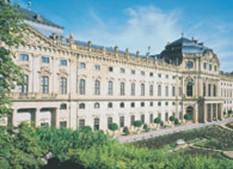
Wuerzburg Residence Palace
In every traveler's life, there are never-to-be-forgotten moments. One of them is the transformation that begins at the exit from the A-7 Autobahn, where you enter the Romantic Road. One of the most famous of the German Vacation Routes wends its way from Wuerzburg to Fuessen.
The Romantic Road is a 220-mile journey from the River Main to the Alps that offers the traveler what is simply one of the most beautiful and most engaging melange of scenery, cuisine and ambience Germany can offer.
It's all gorgeous - the stunning Wuerzburg Residence Palace, the centuries-old panorama and magical atmosphere of Rothenburg-ob-der-Tauber and Dinkelsbühl, the Roman remains in Augsburg, Bavarian King Ludwig II's unforgettable dream-† castle of Neuschwanstein.
†
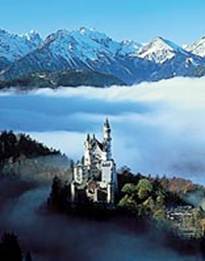
Castle of Neuschwanshtein
Wherever travellers find themselves on the Romantic Road, exceptional cuisine, delicious wines, glorious land- and city-scapes, castles, churches and fortresses inspire the appetite and the soul. Here, in one of the most charming and beautiful sections of Germany, even the most cynical and unromantic traveler cannot help but be seduced.
B) The Classic route.
Whether
we pass through Erfurt, Weimar, Jena or Gotha, names such as Goethe, Schiller,
Wagner and Strauss always linger on any trip through the "green heart of Germany".
†††† The town of Eisenach is known as the home of the "Wartburg", the
castle once inhabited by the famous Martin Luther. It is also, however, the
city of minstrels and birthplace of Johann Sebastian Bach, whose history can be
traced in the local "Bach House" museum. Eisenach is a medieval town
which both Goethe and Wagner liked to visit, and it is a joy to wander through
the splendid forest landscapes of this area.
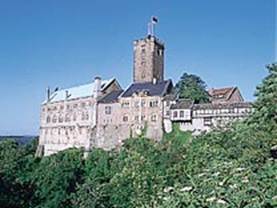
Wartburg castle
Along the
classic route, Gotha is also worth a visit. The "Friedenstein Palace" and annual events such as the "Ekhof Festival" all contribute to give
the town a unique touch. In Arnstadt, we reach "the gateway to the Forest of Thuringia ".
Excursions to the "Wachsenburg Fortress", "Gleichen Castle
Ruins" and "Mühlburg Ruins" are highly recommended.
Next stop is Weimar, "European Cultural City 1999", which links† to Goethe and Schiller. Besides "Goethe's
residence", his "summer-house on the Ilm" and the "German
National Theater", the "Goethe National Museum" represents a special
attraction in the city. Not far from Weimar is a town called Jena, known
foremost for the work and life of Friedrich Schiller and which has therefore
become a popular destination.
—) The Castle Road
Historical places and charming countryside with many romantic
fortresses and fairy tale castles make the 975 km long castle route from Mannheim to Prague a varied route. The glory of time's past still has
an effect today on many towns and villages.
††††† The countryside is as
varied as the history. The river Neckar winds its way through the Odenwald, the
Hohenloher Ebene seems to stretch endlessly into the distance, next the rolling
Frankenhöhe and then the northern part of so-called Franconian
Switzerland. The legacy of the artloving Electors of the Palatinate can still
be admired in towns such as Mannheim, Heidelberg or Schwetzingen.
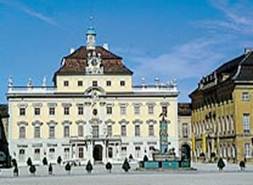 ††††††
††††††  ††††
††††
†Ludwigsburg Castle††††††††† †††††††††††††††††††††††††††† Schwerin Castle
On the tracks of the Palatinate Earls, Mosbach, Neckarzimmern or Bad Wimpfen
are certainly well worth a visit, with their picturesque old town centres and
romantic halftimbered houses. Near Heilbronn the route passes through
winegrowing areas, the medieval free city of Nuremberg and the vererable towns
of Rothenburg o. d. Tauber, Coburg, Kronach, Kulmbach, Bayreuth right through
to Karlsbad and Marienbad, the famous spa towns, to eventually reach Prague,
the capital of the Czech Republic.
All these towns with their 70 fortresses, ruins and castles line the castle route like many pearls in a row and present themselves as impressive witnesses to the past. Medieval towns, monasteries, historic buildings and cultural treasures make sure the journey along the castle route becomes a special and varied experience.
5. A Journey to Berlin
The might and scope of Prussian achievement is manifest in Berlin, one of the world's most fascinating and troubling cities. Of strategic importance since it first straddled the Spree River in the 13th century, Berlin never hogged centre stage quite like it did this century. This is the heart of Germany, its stoic beat echoing through grand public buildings, glorious museums and theatres, and its urbane restaurants, bustling pubs and raucous nightclubs. Today, the city, restored as the nation's capital, is the focus of the mammoth project of reunification and readings of Germany's mood are taken most accurately here.
Berlin is a good city to explore on foot. Take time to stroll from Alexanderplatz to the Brandenburg Gate along Unter den Linden. The nearby Kulturforum is a cluster of museums and concert halls on the south-eastern side of Tiergarten that can take days to explore.
5.1. Accommodation in Berlin
During the cultural festivals? Trade fairs and conferences? Hotels are totally booked up. The flood of tourists has increased since the opening of the wall. Unless you have alternative accommodation, a spur-of-the-moment trip to Berlin can be marred by an unpleasant or futile search for a hotel room. Reservations made several weeks in advance are definitely recommended.
Luxury Hotels
1. Bristol Hotel Kempinski (Kurfurstendamm 27) Ц The epitomy of traditional luxury
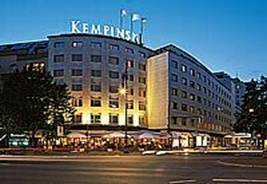
2. Grand Hyatt Berlin
In the new heart of Berlin at Potsdamer Platz, the modern design hotel Grand Hyatt Berlin is adjacent to restaurants, shopping arcades, a casino and the city's main musical theatre. The Philharmonic Theatre, New National Gallery and Picture Gallery are located in the immediate neighbourhood; the Government District, the city park Tiergarten and Berlin's greatest cultural treasures are within walking distance. The city train and subway stations at Potsdamer Platz are nearby, and Tegel International Airport is 9.4 miles/15 kilometres from the hotel.
3. Grand Hotel Esplanade ( Lutzowufer 15)† - The modern, polished design emphasises functional luxury. Centrally located between the Kurfurstendammm, Unter den Linden and Potsdamer Platz, opposite the Tiergarten Park, this designer hotel captures the spirit of contemporary Berlin in a sophisticated setting. The hotel offers flexible and attractive conference and banqueting rooms for up to 450 people. Hotel room have bathroom, WC, telephone, fax, modem-connection, radio, TV, safe, minibar, sound insulation, air conditioning, restaurants, 2 bars, swimming pool, whirlpool, 3 saunas, solarium, beauty center, massage, fitness center, hairdressing salon, 6 conference rooms for up to 450 persons, garage parking, and conference boat. The УEsplanadeФ is a 5-star boat available for conferences, parties and private celebrations. Room facilities: Air conditioning, Minibar, Radio, Safe, Satellite TV, Sound insulation, Telephone with modem-connection.
4. Inter-Continental (Budapester strasse 2) Ц the largest hotel in town. Famous for its luxury.
5. Palace Hotel (Budapester strasse 45)
†This luxury 5-star city hotel presents 282 individually decorated rooms, including 32 suites about 55 - 225 sqm. Cable TV, refrigerated mini bar, trouser press, soundproofed windows and further extras belong to our standard. Its suites are appointed with marble bathrooms, exclusive hifi, as well as whirlpool and large dressing rooms. The elegant banqueting floors offer 12 different function rooms that can be extended to accommodate 10 - 700 persons as well as 5 banquet rooms in the adjoining Business Centre. Breakfast restaurant "Bon Dia", "Lounge" and "Sam's Bar" offering snacks and cocktails. Michelin-rated-Restaurant "First Floor" with chef Mathias Buchholz, Cafe-Restaurant "Tiffany's" and the rustic restaurant "Alt- Nurnberg" in the bordering Europa-Center. Money exchange, room service, laundry- and shoe cleaning service. Admission free to the "Thermen am Europa-Center", a large health spa with sauna and swimming pool.
First-class Hotels
Art hotel Sorat (Joachimstaler Strasse 28-29) Ц Art and accommodation: the Wolf Vostell designer furniture sculptures make each room a unique experience.
Avantgarde (Kurfurstendamm 15) Ц Neo-Baroque house with huge rooms decorated with stucco mouldings.
Artemisia (Branderburgishe Strasse 18) Ц tiny, attractively decorated hotel reserved exclusively for women.
Dom Hotel (Mohrenstrasse 30, Mitte) Ц fine modern hotel overlooking the most beautifull square in the city: the Platz der Academy.
Mondial (Kurfurstendamm 47) Ц spacious rooms. The entire hotel is designed for use by handicapped.
Hotels & Pensions.
Alpina (Trabener Strasse 3) Ц small villa with garden near the Grunewald S-Bahn Station.
Kreuzberg (Grossbeerenstrasse 64) Ц for young, undemanding guests.
Savoy (Meinekestrasse 4) Ц Small but nice.
Terminus (Fasanenstrasse 48) Ц neither plush nor dingy.
Transit (Hagelberger Strasse 53-54) Ц Charming hotel for young people who care more for atmosphere than luxury.
Youth accommodation
Jugendherberge Bayernalee
(youth hostel) Ц Bayernalee 36
Jugendgastehaus am Wannsee
†(youth guest house) Ц Badeweg 1
Jugendgastehaus BERLIN
†(youth guest house) Ц Kluckstrasse 3
Jugendgastehaus am Zoo
(youth guest house) Ц Hardenbergstrasse 9a
Jugendtouristenhotel
(youth guest house) Ц Franz-Mett-Strasse 7
5.2. Sightseeing in Berlin
A) The Brandenburg Gate (Brandenburger Tor)
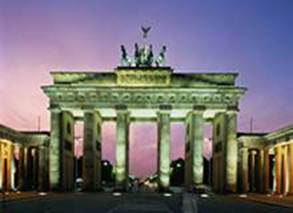
The Brandenburg gate is the unquestionable symbol of Berlin and is now regarded as one of the greatest symbols of German unity. It is the last remaining gate of the Berlin Wall and marks the western end of the famous Unter den Linden Boulevard. The statue on top of the arch represents Nike driving her chariot to victory towards the West.
B) Museum Island (Museumsinsel)
The Berlin Museumsinsel is a unique ensemble of museum buildings that illustrate the evolution of modern museum design over more than a century. The museums include The National Gallery, The Old Museum (Altes Museum), The Pergamon Museum and The Bode Museum.
The National Galerie is an ultra-modern building built in the 1960s. The museum collection specialises in works from the 19th and 20th centuries as well as international contemporary art. The National Galerie is famous for its collection of French impressionists.
The Old Museum houses an amazing collection of 18th, 19th and early 20th-century paintings and statues. Any prominent artist you can think of it probably featured here.
The Pergamon Museum is immense. It is divided into five sections: the Antiquities Collection, the Middle East Museum, the Islamic Museum, the Far East Collection, and the Museum of Popular Art. A few days is needed to properly explore it.
The Bode Museum's original collection of Egyptian artifacts was very badly affected by World War II. However, there are outstanding exhibits of Byzantine and early Christian relics on show.
B) The Tiergarten
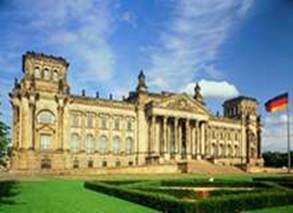
The Tiergarten is often referred to as BerlinТs green heart. Originally a hunting reserve for royalty, landscape architect Peter Joseph Lenne turned the Tiergarten into a beautiful city park in 1742. During World War II many of the trees were cut for firewood and the pristine lawns were turned into vegetable gardens to feed the populace of Berlin. Heavy bombing then damaged much of the rest of the park. The present-day plantings took place just after the war and today the beautifully lush Tiergarten is a popular place with Berliners and, to the surprise of many tourists, nude sunbathing is permitted throughout the park. The park is over 412-acres and it stretches for 1.75 miles west from the Brandenburg Gate.
D) The Berlin Wall
If you want to see what remains of the infamous Berlin Wall head down Charlottenstrasse and then west along Leipzigerstrasse. There you can see one of the best examples of what remains of the Wall.
E) The Berlin Radio Tower
The Berlin Radio Tower was built in 1924 for the Third German Broadcasting Exhibition. Standing at 138-meters high, this steel-latticed tower is a fantastic viewing point with panoramic birdТs-eye views of the city. An elevator takes you to the observation deck at 125 meters to admire the vista. There is a restaurant at the 55-meter level.
F) The Charlottenburg Palace (Schloss Charlottenburg)
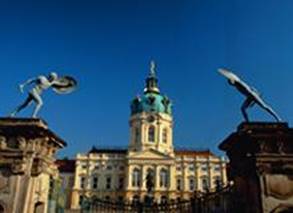
The Charlottenburg Palace is the oldest surviving Prussian palace in Germany. Building began in 1695 and was completed in 1790. There are 70 rooms and corridors crammed full of ornate furnishings and Watteau paintings. The east wing houses an incredible collection of romanticist paintings while the west wing houses a collection of ancient and prehistoric art and artifacts. Take a guided tour of the royal apartments and then stroll through the formal gardens that surround the palace.
G) The Reichstag
The
Reichstag, built in 1884-94, has witnessed many of the key moments in 20th
century German history. It has seen the Proclamation of the German Republic in 1918, endured a burning in 1933, a storming in 1945 by Russian troops and
German Reunification in 1990. Since its renovation in 1999, it has housed the
Bundestag (Parliament).
H) Soviet War Memorial (Treptower Park)
Treptower Park houses a very sobering monument to the Soviet soldiers who died fighting Hitler. The park also contains a mass grave for the 5,000 soldiers killed in action. Walk the tree-lined avenue to see a statue of Mother Russia crying for her dead children. There are huge white stone reliefs set up in a manner not unlike the Stations of the Cross. They bear quotations from Stalin and depict how the Soviets won out against Fascism. At the far end of the park there is a massive statue of a heroic Soviet soldier clutching a child in one arm and smashing a swastika with the other.
I) The Jewish Quarter
The Scheunenviertel (Stable Quarter) is both Berlin's newest hot spot and one of its oldest areas. It was originally founded in the 17th century outside the medieval city walls. It survived Allied bombing raids and the Red Army's assault on the city. Recently, the quarterТs old buildings are being reincarnated as trendy bars, cafes, restaurants, and galleries. It is lively, trendy and bohemian and well worth a visit.
5.3. Eat, Drink, Nightlife
Berlin offers a wide range of possibilities to go out. Restaurants, Pubs and clubs of all kind and for every gusto invite you. Many places and streets are perfect night walks because one restaurant is here next to the other.
Many restaurants invite you to discover the delicacies of Berlin's cuisine. In a cosy ambiance you can savour the regional specialities and discover the variety of typical food along the meetballs (Bouletten) and Berliner Weiße (beer with juice).
The whole world is at home in Berlin. Restaurants offer food from around the world, from Argentina to Zimbabwe, folkloristic or exclusive. You are at the right place in Berlin to go on a culinary journey around the world or to discover really particular food.
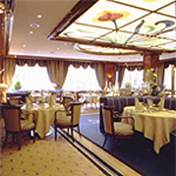 †††††††††
††††††††† 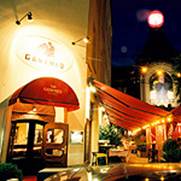
Savigny-Platz
Night owls with stamina can also give their undivided attention to the interesting range of pubs around Savignyplatz in Charlottenburg. The area consist of a great number of restaurants and bars where everyone can meet the stars of television or Berlin's culture and political scene. Here is the melting pot that combines symbolically the former west and the new centre to a harmonic construction.
Pariser Straße and Ludwigkirchplatz
Especially the younger crowd is attracted to the Pariser
Straße. At this location you will find taverns, bars, American diners,
Mexican restaurants and very modern and stylish discos. During the summer life
concentrates on the street in form of many chairs and tables that invite us to
rest. In the middle of this street the well-maintained Ludwigkirchplatz with
its rich areas of green providing a relaxing shadow is located.
The Winterfeldtplatz and Schöneber
The Winterfeldtplatz is the location of a frequently visited market. In the numerous taverns and bars, plenty of customers, tourists and locals meet each other. The scene is uncomplicated and open minded, also due to the presence of Berlin's gay population.
In Goltzstraße the Schönebergers meet in places such as the Café M, Lux or one of the numerous Indian snack bars. Between Schöneberg and Tiergarten the 90∞ is still an up-to-date party location. But the Latinamerican Clubs El Barrio or the Caracas Bar invite for a visit as well.
Conclusion.
Germany is among the most attractive countries for tourists because it has developed tourist and hospitality industry. In every city or even in the country tourists have an opportunity to find accommodation and to taste the national dishes. And there are everywhere numerous places of interest in Germany.
Every year a lot of tourists visit Germany to see its amazing and outstanding sightseeing. There is no doubt that tourists
visited Germany wouldnТt be disappointed.
1.Western Europe on a shoestring.
2.Berlin. Insight pocket guide.
Sites1. www.berlin-tourist-information.com
2. www.germany-tourism.de
3.
www.lonelyplanet.com
